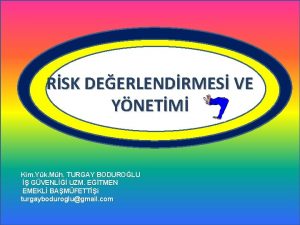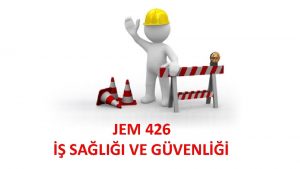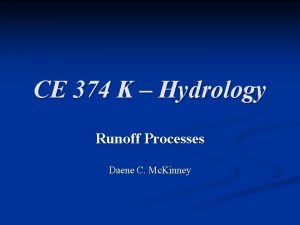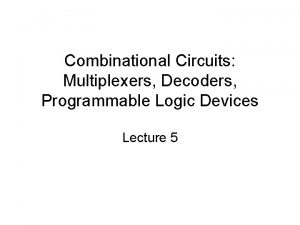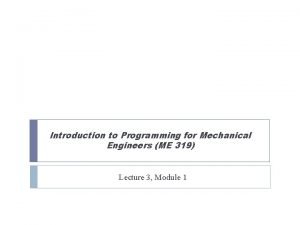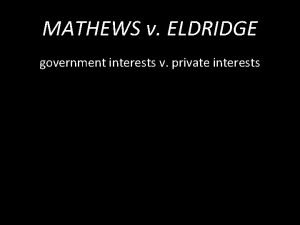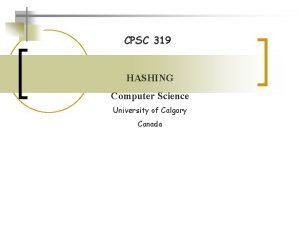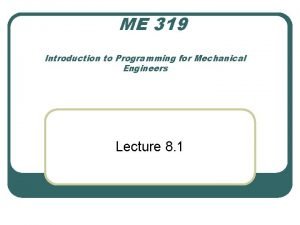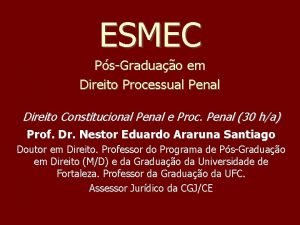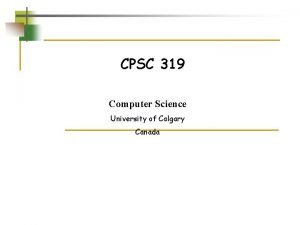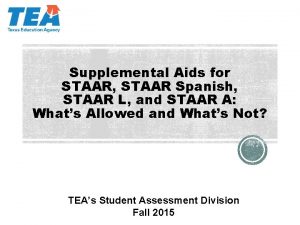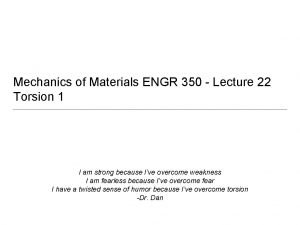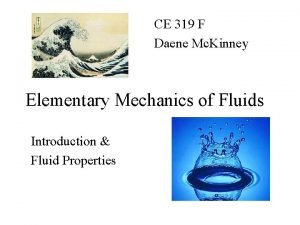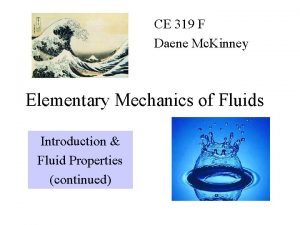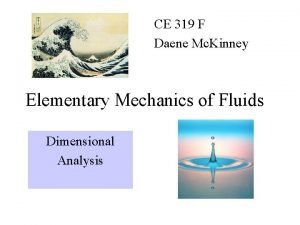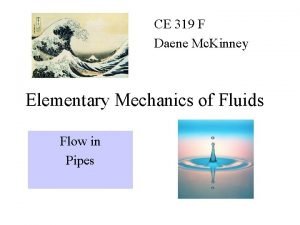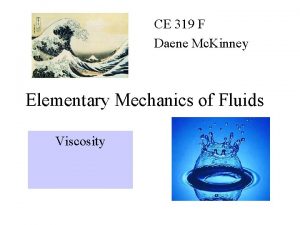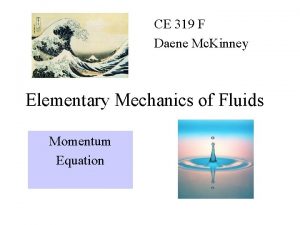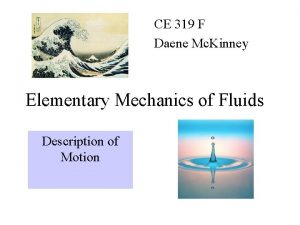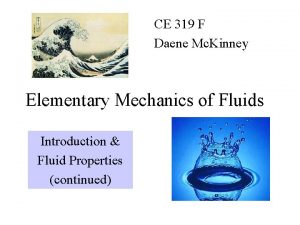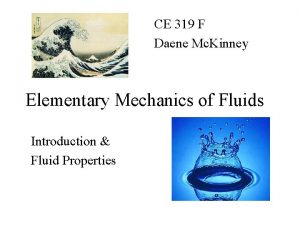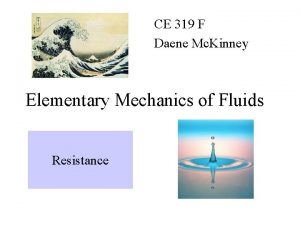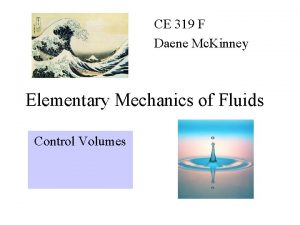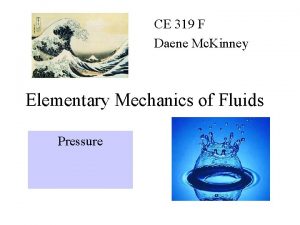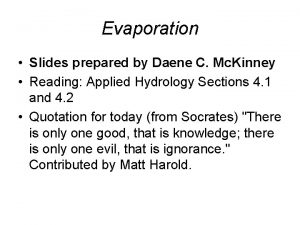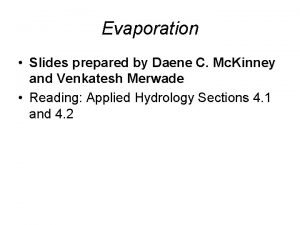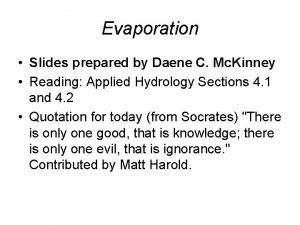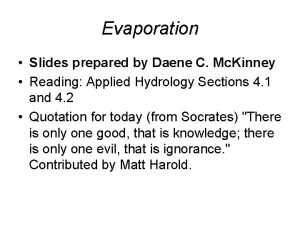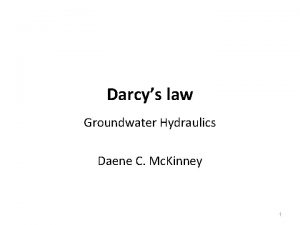CE 319 F Daene Mc Kinney Elementary Mechanics






















- Slides: 22

CE 319 F Daene Mc. Kinney Elementary Mechanics of Fluids Bernoulli Equation

Euler Equation • • Fluid element accelerating in l direction & acted on by pressure and weight forces only (no friction) Newton’s 2 nd Law

Ex (5. 1) • • Given: Steady flow. Liquid is decelerating at a rate of 0. 3 g. Find: Pressure gradient in flow direction in terms of specific weight. Flow l 30 o

EX (5. 3) • • vertical Given: g = 10 k. N/m 3, p. B-p. A=12 k. Pa. Find: Direction of fluid acceleration. A 1 m B

HW (5. 7) • Ex (5. 6) What pressure is needed to accelerate water in a horizontal pipe at a rate of 6 m/s 2?

Ex (5. 10) • • Given: Steady flow. Velocity varies linearly with distance through the nozzle. Find: Pressure gradient ½-way through the nozzle V 1/2=(80+30)/2 ft/s = 55 ft/s d. V/dx = (80 -30) ft/s /1 ft = 50 ft/s/ft

HW (5. 11)

Bernoulli Equation • Consider steady flow along streamline • s is along streamline, and t is tangent to streamline

Ex (5. 47) Point 1 • • • Given: Velocity in outlet pipe from reservoir is 6 m/s and h = 15 m. Find: Pressure at A. Solution: Bernoulli equation Point A

Example • • Given: D=30 in, d=1 in, h=4 ft Find: VA • Solution: Bernoulli equation Point 1 Point A

Example – Venturi Tube • • • Given: Water 20 o. C, V 1=2 m/s, p 1=50 k. Pa, D=6 cm, d=3 cm Find: p 2 and p 3 Solution: Continuity Eq. D D d 2 1 3 Nozzle: velocity increases, pressure decreases • Bernoulli Eq. Diffuser: velocity decreases, pressure increases Similarly for 2 3, or 1 3 Pressure drop is fully recovered, since we assumed no frictional losses Knowing the pressure drop 1 2 and d/D, we can calculate the velocity and flow rate

Ex (5. 48) • • • Given: Velocity in circular duct = 100 ft/s, air density = 0. 075 lbm/ft 3. Find: Pressure change between circular and square section. Solution: Continuity equation Air conditioning (~ 60 o. F) • Bernoulli equation

Ex (5. 49) • • Given: r = 0. 0644 lbm/ft 3 V 1= 100 ft/s, and A 2/A 1=0. 5, gm=120 lbf/ft 3 Find: Dh Solution: Continuity equation • Bernoulli equation • Heating (~ 170 o. F) • Manometer equation

HW (5. 51)

Stagnation Tube

Stagnation Tube in a Pipe 2 Flow 1

Pitot Tube

Pitot Tube Application (p. 170) V 1 z 1 -z 2 2 l y

HW (5. 69)

HW (5. 75)

HW (5. 84)

HW (5. 93)
 Matris yöntemi
Matris yöntemi Fine kinney metodu
Fine kinney metodu Fine kinney method
Fine kinney method Kinney encoder
Kinney encoder Kinney philippines
Kinney philippines Rebecca kinney
Rebecca kinney Breadth length depth height
Breadth length depth height Crime prevaricação
Crime prevaricação Cwa 319
Cwa 319 Me 319
Me 319 Denunciacao caluniosa
Denunciacao caluniosa 87,539,319 = 2283 + _ _ _ 3
87,539,319 = 2283 + _ _ _ 3 Mathews v eldridge test
Mathews v eldridge test Pc 319
Pc 319 Cpsc 319 u of c
Cpsc 319 u of c Me 319
Me 319 Hsci 319
Hsci 319 Crime prevaricação
Crime prevaricação Cpsc 319 u of c
Cpsc 319 u of c Pictorial models of geometric figures
Pictorial models of geometric figures Mechanics of materials
Mechanics of materials Engineering moments
Engineering moments Fdown.nrt
Fdown.nrt
